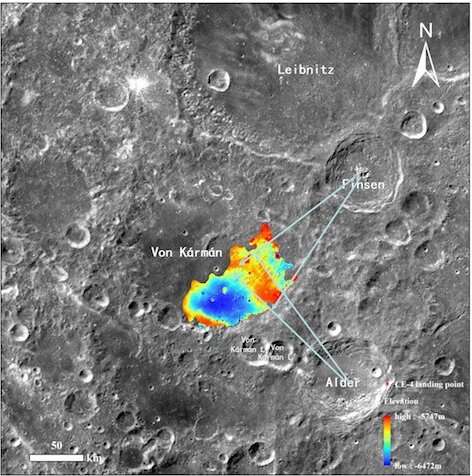Context map of Chang'e-4 landing site showing ejecta from Finsen and Alder craters. Credit: AIR
China's Chang'e-4 probe achieved the first soft landing within the South Pole-Aitken (SPA) basin, which is the oldest, largest and deepest basin on the lunar farside. Technologies and software have been used in the Chang'e-4 mission for studies like lander localization, 3-D terrain reconstruction, hazard recognition, and visual localization of the rover.
Researchers from the Aerospace Information Research Institute (AIR) of the Chinese Academy of Sciences (CAS) have long been engaged in developing advanced technologies of lunar rover localization and surface environment perception for the Chang'e-4 lunar exploration mission.
The researchers and their collaborators also carried out studies on topographic evolution analysis and surface mineral retrieval using images and spectral data acquired by the Yutu-2 rover.
According to their recent study published in Icarus, analysis via spectral unmixing revealed that the regolith at Chang'e-4 landing site has a forsteritic olivine and magnesium-rich orthopyroxene assemblage in almost equal fractions.
Surrounding topographic and geologic context indicated that the regolith is primarily the weathering products of Finsen crater ejecta. Because the SPA forming event should have thinned the lunar crust and might generate an impact melt pool, the provenance of regolith is likely a differentiated SPA impact melt pool or an Mg-suite pluton in the lunar lower crust.
Based on the data obtained by Chang'e-4, AIR researchers have unveiled more and more mysteries about the Moon.
Detailed topographic analysis of the landing site revealed the topographic evolution of the SPA and demonstrated that the surface material explored by the Yutu-2 rover was lunar deep interior material excavated from Finsen crater with possible contributions from Alder crater rather than the underlying mare basalt (Di et al., 2019).
Spectral parameter scatter plots of in situ measured spectra by Chang'e-4 rover were in favor of a mixture of olivine-orthopyroxene minerals in the regolith. According to the surrounding topographic and geologic context, the regolith at Chang'e-4 landing site was primarily the weathering products of lunar deep-seated materials excavated from Finsen crater (Gou et al., 2019).
Spectral simulation revealed that the regolith was mature after billions of years' space weathering. Compared with the sub-mature regolith at Chang'e-3 landing site, the submicroscopic metallic iron abundance in the regolith at Chang'e-4 landing site did not vary significantly with distance from the lander (Gou et al., 2020).
The researchers also conducted high precision landing site topographic mapping using orbital, descent and rover images in the Chang'e-4 mission, resulting in DEMs and digital orthophoto maps of meter-level to centimeter-level resolutions (Liu et al., 2020; Wang et al., 2020).
More information: Sheng Gou et al. Forsteritic olivine and magnesium-rich orthopyroxene materials measured by Chang'e-4 rover, Icarus (2020). DOI: 10.1016/j.icarus.2020.113776
Kaichang Di et al. Topographic Evolution of Von Kármán Crater Revealed by the Lunar Rover Yutu‐2, Geophysical Research Letters (2019). DOI: 10.1029/2019GL085252
Sheng Gou et al. In situ spectral measurements of space weathering by Chang'e-4 rover, Earth and Planetary Science Letters (2020). DOI: 10.1016/j.epsl.2020.116117
Sheng Gou et al. Lunar deep materials observed by Chang'e-4 rover, Earth and Planetary Science Letters (2019). DOI: 10.1016/j.epsl.2019.115829
Journal information: Icarus , Geophysical Research Letters , Earth and Planetary Science Letters
Provided by Chinese Academy of Sciences
























